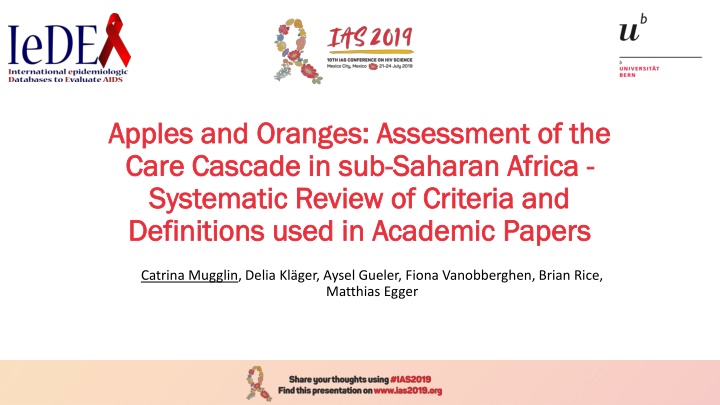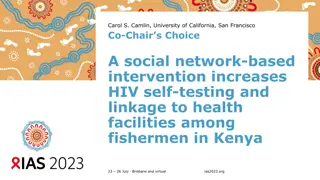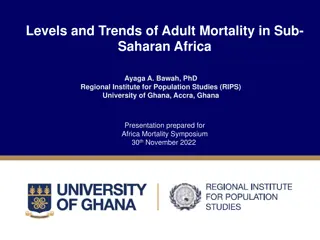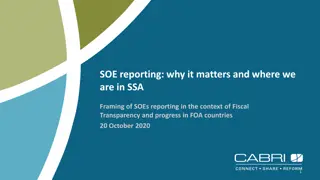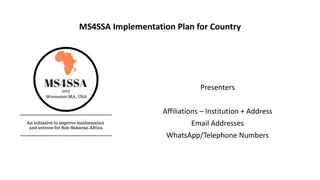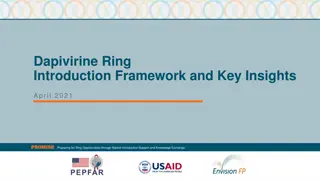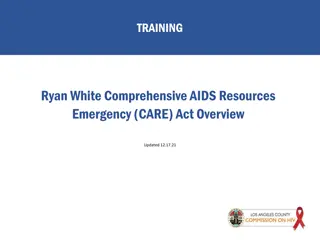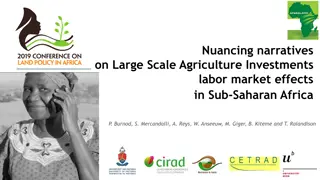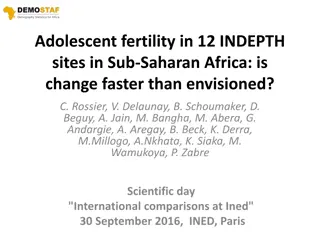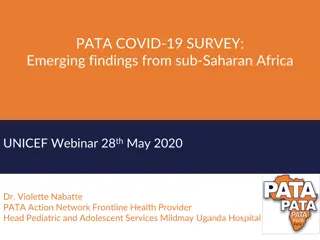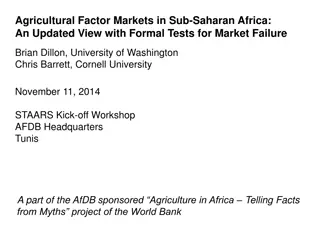Assessment of the HIV Care Cascade in Sub-Saharan Africa
This systematic review evaluates the methodological approaches and participant retention in the HIV care cascade in Sub-Saharan Africa. It covers various steps from pre-ART initiation to viral suppression, providing insights into the challenges and successes in HIV care in the region.
Download Presentation

Please find below an Image/Link to download the presentation.
The content on the website is provided AS IS for your information and personal use only. It may not be sold, licensed, or shared on other websites without obtaining consent from the author.If you encounter any issues during the download, it is possible that the publisher has removed the file from their server.
You are allowed to download the files provided on this website for personal or commercial use, subject to the condition that they are used lawfully. All files are the property of their respective owners.
The content on the website is provided AS IS for your information and personal use only. It may not be sold, licensed, or shared on other websites without obtaining consent from the author.
E N D
Presentation Transcript
Apples and Oranges: Assessment of the Apples and Oranges: Assessment of the Care Cascade in sub Care Cascade in sub- -Saharan Africa Systematic Review of Criteria and Systematic Review of Criteria and Definitions used in Academic Papers Definitions used in Academic Papers Saharan Africa - - Catrina Mugglin, Delia Kl ger, Aysel Gueler, Fiona Vanobberghen, Brian Rice, Matthias Egger
Background Study Selection and Data Extraction Reporting on at least two steps of the HIV care cascade Reporting defined as providing number or percentage for the step Extracted definitions for numerator and denominator at each reported step Monitoring and evaluation are needed to track linkage and retention throughout the continuum of care Methods Systematic review to identify the different methodological approaches used to define the steps in the HIV care cascade in sub- Saharan Africa (SSA), and to assess the proportion of participants retained at each step Articles reporting on steps of the HIV cascade in SSA Cross-sectional and cohort studies included Linked to pre-ART Suppressed VL Retention pre- ART initiation Retention on Diagnosed PLHIV care ART ART On ART 2
Results Study Characteristic (N=58) Year of publication No. of people included Study design Longitudinal study Cross-sectional study Mixed design No. of steps covered Duration of follow-up (years) No. of countries included Region Central Africa East Africa Southern Africa West Africa Multi-regional study No. of sites No. of studies at national level Data collection methods Routine clinical records Questionnaires Samples collected specifically 2014 (2012-2015) 1,494 (466-6,766) 44 (75.9%) 10 (17.2%) 4 (6.9%) 3 (2-4) 3 (2-5) 16 3 (5.2%) 15 (25.9%) 30 (51.6%) 7 (12.1%) 3 (5.2%) 2 (1 10) 2 (2.4%) 44 (75.9%) 26 (44.8%) 25 (43%) 3
No. of studies reporting No. of definitions numerator No. of definitions denominator HIV care cascade step Type of data People living with HIV Cross-sectional and longitudinal 1 8 6 5 Diagnosed with HIV Cross-sectional and longitudinal 2 14 4 2 Linked to pre- ART care Cross-sectional and longitudinal 3 22 10 8 Retention in pre- ART care Cross-sectional and longitudinal 4 16 9 9 Cross-sectional and longitudinal Cross-sectional Cross-sectional and longitudinal Cross-sectional and longitudinal 5 ART initiation 26 15 6 6 On ART Retention on ART 9 4 6 7 28 12 2 8 Viral suppression 34 21 12 4
No. of studies reporting No. of definitions numerator No. of definitions denominator HIV care cascade step Type of data People living with HIV Cross-sectional and longitudinal 1 8 6 5 Numerator: Diagnosed with HIV Cross-sectional and longitudinal Self-reported ART use Pill counts as assessed by counsellor ART use assessed through clinical records Positive blood test for ART drug level 2 14 4 2 Linked to pre- ART care Cross-sectional and longitudinal 3 22 10 8 Retention in pre- ART care Cross-sectional and longitudinal 4 16 9 9 Cross-sectional and longitudinal Cross-sectional Cross-sectional and longitudinal Cross-sectional and longitudinal Denominator: 5 ART initiation 26 15 6 6 On ART Retention on ART 9 4 6 HIV+ participants Participants currently in HIV care Self-reported Assessed through clinical records 7 28 12 2 8 Viral suppression 34 21 12 5 5
No. of studies reporting No. of definitions numerator No. of definitions denominator HIV care cascade step Type of data People living with HIV Cross-sectional and longitudinal 1 8 6 5 Numerator: Diagnosed with HIV Cross-sectional and longitudinal Viral load threshold ranged from < 25 copies / ml to < 5,000 copies / ml 2 14 4 2 Linked to pre- ART care Cross-sectional and longitudinal 3 22 10 8 Time points at which viral suppression was assessed ranged from 1 month on ART to 10 years on ART Retention in pre- ART care Cross-sectional and longitudinal 4 16 9 9 Cross-sectional and longitudinal Cross-sectional Cross-sectional and longitudinal Cross-sectional and longitudinal 5 ART initiation 26 15 6 6 On ART Retention on ART 9 4 6 7 28 12 2 8 Viral suppression 34 21 12 6 6
No. of definition s: numerato r No. of studies reporting No. of definitions: denominator HIV care cascade step Type of data People living with HIV Cross-sectional and longitudinal 1 8 6 5 Diagnosed with HIV Cross-sectional and longitudinal 2 14 4 2 Linked to pre- ART care Cross-sectional and longitudinal 3 22 10 8 Retention in pre-ART care Cross-sectional and longitudinal 4 16 9 9 Cross-sectional and longitudinal 5 ART initiation 26 15 6 6 On ART Cross-sectional 9 4 6 Retention on ART Cross-sectional and longitudinal 7 28 12 2 Viral Cross-sectional and longitudinal 8 34 21 12 suppression 7
Conclusion No. of studies reporting No. of definitions numerator No. of definitions denominator HIV care cascade step Most studies reported clear definitions of numerator and denominators used Type of data People living with HIV Cross-sectional and longitudinal Cascade step definitions were heterogeneous, making comparisons across studies difficult 1 8 6 5 Diagnosed with HIV Cross-sectional and longitudinal 2 14 4 2 Linked to pre- ART care Cross-sectional and longitudinal Only few SSA countries, with the majority of the studies coming from southern Africa 3 22 10 8 Retention in pre- ART care Cross-sectional and longitudinal 4 16 9 9 To allow tracking of progress along the care pathway and towards the 90-90-90 targets, comparable measures and definitions of numerator and denominator at each step are needed Cross-sectional and longitudinal Cross-sectional Cross-sectional and longitudinal Cross-sectional and longitudinal 5 ART initiation 26 15 6 6 On ART Retention on ART 9 4 6 7 28 12 2 8 Viral suppression 34 21 12 8 8
Acknowledgements IeDEA-Southern Africa Steering Committee: Matthias Egger (co-PI), University of Bern, Switzerland; Mary-Ann Davies (co-PI), University of Cape Town, South Africa; Frank Tanser, Africa Centre for Health and Population Studies, University of Kwazulu-NatalSouth Africa; Michael Vinikoor, Centre for Infectious Disease Research in Zambia; Eusebio Macete, Centro de Investiga o em Sa de de Manhi a, Mozambique; Robin Wood, Desmond Tutu HIV Centre (Gugulethu and Masiphumelele clinics), South Africa; Kathryn Stinson, Khayelitsha ART Programme and M decins Sans Fronti res, South Africa; Geoffrey Fatti, Kheth Impilo Programme, South Africa; Sam Phiri, Lighthouse Trust Clinic, Malawi; Cleophas Chimbetete, Newlands Clinic, Zimbabwe; Kennedy Malisita, Queen Elizabeth Hospital, Malawi; Brian Eley, Red Cross War Memorial Children s Hospital and Department of Paediatrics and Child Health, University of Cape Town, South Africa; Jochen Ehmer, Solidarmed, Switzerland; Christiane Fritz, SolidarMed SMART Programme, Lesotho; Michael Hobbins, SolidarMed SMART Programme, Mozambique; Kamelia Kamenova, SolidarMed SMART Programme, Zimbabwe; Matthew Fox, Themba Lethu Clinic, South Africa; Hans Prozesky, Tygerberg Academic Hospital, South Africa; Karl Technau, Empilweni Clinic, Rahima Moosa Mother and Child Hospital, South Africa; Shobna Sawry, Harriet Shezi Children s Clinic, Chris Hani Baragwanath Academic Hospital, South Africa. Funding: Research reported in this publication was supported by the National Institute Of Allergy And Infectious Diseases of the National Institutes of Health under Award Number U01AI069924. The content is solely the responsibility of the authors and does not necessarily represent the official views of the National Institutes of Health. Contact: Catrina Mugglin, catrina.mugglin@ispm.unibe.ch; www.iedea-sa.org 9
